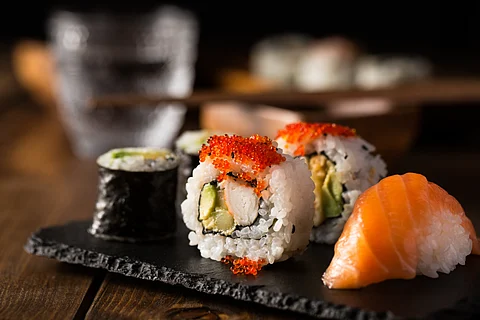
- Destinations
- Experiences
- Stay
- What's new
- Celebrating People
- Responsible Tourism
- CampaignsCampaigns
- Subscribe
- Buy Now

A maki roll, commonly known as makizushi, is a classic Japanese form of sushi. It comprises sour rice that has been flavoured with vinegar. Because the rice is wrapped, it covers things such as vegetables, fish, or seafood.
Maki sushi is made of rice vinegared on the inside and nori (seaweed) on the outside. It also has a variety of fillings, including raw fish and other items. In Japanese, maki sushi is referred to as "norimaki" since nori is one of its primary ingredients.
A maki roll can also be "inside out." The components, for example, are in the centre, and the nori sheet wraps around them. It is then dusted with vinegar rice.
For all of these reasons, there are several varieties of maki rolls available across Japan.
The way it's prepared determines the type of Maki Sushi you'll enjoy. If the ingredients are inside and wrapped with nori, it's called nori outside Maki Sushi. If the rice wraps around the nori, it's known as "inside-out Maki."
Hosomaki is a Japanese term that means "thin rolls." It usually has only one ingredient: eel, tuna, cucumber, or pickled daikon. Nori sheets that are very thin are wrapped around vinegared rice. A bamboo mat is often used to assist in rolling the thin nori sheet into form.
These are about 2 cm in diameter and contain one or two fillings. The fillings are usually placed along the centre of a half sheet of nori, and then the nori is rolled up with rice around it. Hosomaki are often cut into six or eight pieces and served with soy sauce, wasabi, and ginger. Some common fillings for hosomaki are tuna, cucumber, carrot, and pickled radish.
Chumaki is the somewhat bigger relative of the Hosomaki roll, with 2 or 3 ingredients and a diameter of roughly 1 ½ inches when put together.
This size is really the simplest for most people to roll since there is more diameter to "grip." It also helps that there is a 2 1/2-inch bare nori strip at the farthest left side of the roll to seal it, which is the most of any roll.
Futomaki is the largest and thickest of the maki rolls. As a result, it is also known as "fat-rolled sushi." It has a maximum diameter of 2.5 inches. This is because it contains a lot of fresh vegetables, shellfish (anago, unagi, or uni), and fish. The fillings are usually colourful and varied and may include cooked or raw fish, vegetables, eggs, and tofu.
It is then wrapped with sour rice and a thin, toasted sheet of nori. A full sheet of nori is used to wrap the rice and fillings, and the roll is cut into four or six pieces. Futomaki are often eaten during festivals and special occasions, as they symbolise prosperity and happiness.
These are inside-out rolls, where the rice is on the outside, and the nori is on the inside. Uramaki are usually coated with sesame seeds, fish roe, or other toppings to add texture and flavour. The fillings are similar to those of futomaki but may also include cream cheese, mayonnaise, or spicy sauce. Uramaki are more common outside of Japan, especially in the United States, where they are sometimes called reverse rolls or American rolls.
These hand rolls, shaped like cones, are made by wrapping a half sheet of nori around a handful of rice and fillings. Temaki are not cut into pieces but eaten with the fingers. They are usually made to order and eaten immediately, as the nori tend to get soggy over time. Temaki are ideal for parties and gatherings, as they allow guests to choose their fillings and make their rolls.
